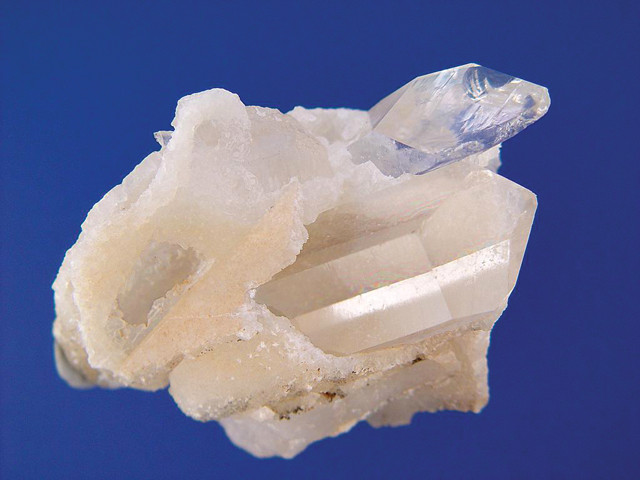
by U.S. Geological Survey Wednesday, June 20, 2018
Thomas P. Dolley, a mineral commodity specialist for the U.S. Geological Survey, compiled the following information on cultured quartz crystal, an essential component of cell phones, computers, clocks and many other devices controlled by digital circuits.

Cultured quartz replaced natural quartz (shown above) in electronic applications in the mid-20th century. Credit: Copyright StoneTrust, Inc., ESW Image Bank
Cultured quartz crystal, also known as electronic-grade quartz crystal, is single-crystal quartz that has properties that make it uniquely useful in electronic circuits for precise filtration, frequency control and timing for consumer and military use. Common uses for cultured quartz crystal include aerospace hardware, commercial and military navigational instruments, computers, clocks, games, television receivers, toys and communications equipment like cell phones.
Natural quartz gained prominence in the developing electronics industry in 1921, when Professor Walter G. Cady discovered that a quartz crystal could be used to control a radio oscillator circuit. Brazil was the only supplier of this natural high-quality quartz material. But a shortage during World War II, when submarines cut off the Brazilian quartz supply to the United States, stimulated research to grow the material synthetically. Natural electronic-grade quartz crystal was the leading form of quartz until 1971, after which cultured quartz took the lead.
For some applications, natural electronic-grade quartz must be cut into thin wafers oriented precisely in line with the raw material crystal axes. It requires special orientation, cutting, grading and sizing to produce a quartz wafer — unlike cultured quartz — and its use has been discontinued. Today, cultured quartz is used almost exclusively by the crystal device industry because of its crystal uniformity, convenience and cost advantages.
Cultured quartz crystal is synthetically produced in large pressurized vessels known as autoclaves. Essential ingredients are seed crystals (very thin cultured quartz crystals cut to exact dimensions), lascas (natural quartz feedstock) and a solution of sodium hydroxide or sodium carbonate, with additives such as lithium salts and deionized or distilled water. At optimal temperatures and pressures, the lascas dissolves and is moved to the cooler top part of the vessel where it deposits on the seed crystals. The process is stopped when the growing crystals reach the desired size and shape.
For more information on cultured quartz crystal and other mineral resources, visit minerals.usgs.gov/minerals.
Mining of lascas (feedstock for cultured quartz) in the United States ceased in 1997, owing to competition from less expensive imported lascas.
Brazil, Madagascar and Canada are the world’s major suppliers of lascas.
China, Japan and Russia lead the world in cultured quartz crystal production.
Cultured quartz crystal has not been produced in the United States since 2003. The United States still has the capacity to produce cultured quartz, but significant refurbishment would be required to bring operations online.
The United States imports all of its cultured quartz crystal. The U.S. government maintains a stockpile inventory of natural quartz crystal.
Quartz is the most abundant and widespread mineral on Earth.
The electrical properties of high-purity quartz were discovered by Marie and Pierre Curie in 1880.
Lascas is a non-electronic grade quartz that is mined and used as feedstock for growing cultured quartz crystal.
Cultured quartz crystals are produced in large pressurized vessels, called autoclaves, at temperatures of 350 to 400 degrees Celsius and pressures of 10,000 to 30,000 pounds per square inch.
Approximately 10 billion quartz crystals and oscillators were manufactured and installed worldwide in all types of electronic devices, from automobiles to cell phones, in 2006.
The average value of a kilogram of cultured quartz in 2007 was approximately $215.
© 2008-2021. All rights reserved. Any copying, redistribution or retransmission of any of the contents of this service without the expressed written permission of the American Geosciences Institute is expressly prohibited. Click here for all copyright requests.